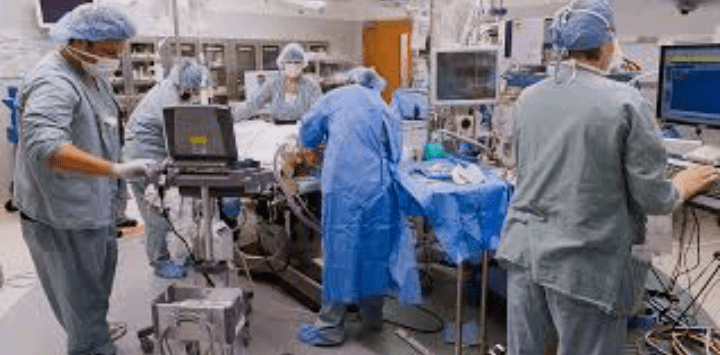What is surgical technology? In the realm of healthcare, this term encapsulates a fascinating array of tools, techniques, and innovations that form the backbone of modern surgical procedures. At its core, surgical technology revolves around the instruments and practices employed by healthcare professionals to conduct surgeries with precision and efficiency.
The journey of surgical technology is a captivating narrative that spans centuries, evolving from the early days of rudimentary tools to the cutting-edge advancements witnessed in contemporary operating rooms.
From the skilled hands of ancient healers wielding primitive instruments to the sophisticated robotic systems revolutionizing surgery today, the field has come a long way, constantly pushing the boundaries of what is achievable.
This article embarks on a comprehensive exploration of surgical technology, unraveling its historical roots, delving into the intricacies of surgical instruments, and deciphering the impact of emerging technologies. From the basic tools like scalpels and forceps to the game-changing innovations in minimally invasive and robot-assisted surgeries, we will navigate the rich tapestry of this vital discipline.
Beyond the technicalities, surgical technology is a dynamic force that involves a collaborative dance in the operating room. Surgical technologists, unsung heroes of the surgical team, play a crucial role in ensuring the seamless execution of procedures. As we embark on this journey of discovery, we will also explore the educational pathways for those aspiring to become part of this integral healthcare profession.
Join us in unraveling the marvels of surgical technology, where precision meets compassion, and innovation converges with the age-old commitment to healing.
Read also: Beginner’s Guide to the Decentralized Web and How it Works
What is Surgical Technology

Historical Evolution of Surgical Technology
The roots of surgical technology trace back through the annals of medical history, entwined with the evolution of surgical instruments. The ancient world witnessed the rudimentary tools used by healers and surgeons, forged from bronze and iron, in their quest to alleviate human suffering. From the iconic Hippocratic Oath to the pioneering works of ancient civilizations, the foundation for surgical technology was laid.
The Renaissance period marked a significant turning point as anatomy became a focal point of study, leading to the development of more sophisticated instruments. Innovators like Andreas Vesalius laid the groundwork for modern surgery, emphasizing the importance of precision and understanding the human body’s intricacies.
As time progressed, surgical tools evolved from primitive devices to finely crafted instruments, setting the stage for the technological revolution that was to come.
The Technological Revolution in Surgery
The latter half of the 19th century witnessed a surge in technological innovations that revolutionized the landscape of surgery. The advent of anesthesia transformed the surgical experience, allowing for more intricate and prolonged procedures. Simultaneously, the introduction of antiseptic techniques by pioneers like Joseph Lister significantly reduced postoperative infections, enhancing patient outcomes.
The 20th century ushered in an era of unprecedented technological advancements, with the development of antibiotics, imaging techniques, and minimally invasive procedures. The introduction of X-rays, computed tomography (CT), and magnetic resonance imaging (MRI) provided surgeons with invaluable insights into the human body’s internal structures.
These innovations not only improved preoperative diagnostics but also paved the way for more accurate and targeted interventions.
Surgical Instruments and Equipment
At the heart of surgical technology lies a vast array of meticulously crafted instruments and equipment designed to facilitate precise and efficient procedures. From the traditional scalpel to state-of-the-art robotic surgical systems, the arsenal available to surgeons has expanded exponentially.
a. Basic Surgical Instruments:
Scalpel: A precision cutting tool used for making incisions.
Forceps: Grasping and holding instruments for manipulating tissues and objects.
Scissors: Cutting instruments designed for various tissues and purposes.
Needle Holders: Devices for holding and manipulating needles during suturing.
b. Advanced Surgical Instruments:
Laparoscopic Instruments: Miniature instruments used in minimally invasive procedures.
Electrocautery Devices: Tools for cutting or coagulating tissues using electrical currents.
Endoscopic Cameras: Miniaturized cameras for visualizing internal structures during procedures.
Surgical Lasers: Precision instruments for cutting or cauterizing tissues with focused laser beams.
c. Robotic Surgical Systems:
Da Vinci Surgical System: A robotic platform that enables surgeons to perform minimally invasive procedures with enhanced precision.
Zeus Surgical System: An early robotic system designed for assisting surgeons in complex procedures.
The advent of robotic surgical systems has been a game-changer in the realm of surgery. These systems, exemplified by the Da Vinci Surgical System, offer unparalleled precision and dexterity, allowing surgeons to perform intricate procedures through small incisions with enhanced 3D visualization.
Minimally Invasive Surgery
Minimally invasive surgery (MIS), often referred to as laparoscopic surgery, has emerged as a cornerstone of contemporary surgical practice. This transformative approach minimizes the physical trauma to patients by utilizing small incisions and specialized instruments. The benefits of MIS include reduced pain, faster recovery times, and diminished scarring compared to traditional open surgeries.
The laparoscope, a thin tube with a camera and light source, serves as the eyes of the surgeon during MIS procedures. Surgeons manipulate miniature instruments through small incisions, guided by real-time images displayed on monitors. Common MIS procedures include laparoscopic cholecystectomy (gallbladder removal), laparoscopic appendectomy, and laparoscopic hysterectomy.
Robot-Assisted Surgery
Building upon the principles of MIS, robot-assisted surgery has emerged as a groundbreaking paradigm in surgical technology. The Da Vinci Surgical System, a pioneering robotic platform, allows surgeons to control robotic arms with enhanced precision, offering a three-dimensional view of the surgical field. The robotic arms mimic the surgeon’s hand movements with increased dexterity, enabling complex procedures with unparalleled accuracy.
Robot-assisted surgery has been successfully employed in various specialties, including urology, gynecology, and general surgery. Prostatectomies, hysterectomies, and colorectal surgeries are among the procedures where robotic systems have demonstrated superior outcomes.
While the cost of implementing robotic systems remains a consideration, the potential benefits in terms of patient outcomes and reduced hospital stays underscore the transformative impact of this technology.
The Role of Surgical Technologists
Amidst the sophisticated machinery and advanced techniques, surgical technologists play a pivotal role in the seamless execution of surgical procedures. These skilled professionals, also known as surgical technicians or scrub techs, work alongside surgeons and nurses to ensure the operating room functions like a well-oiled machine.
The responsibilities of surgical technologists encompass a spectrum of tasks, from preparing the operating room and sterilizing equipment to handing instruments to surgeons during procedures.
Their expertise in maintaining a sterile environment and anticipating the surgeon’s needs contributes to the overall efficiency and safety of surgical interventions. Surgical technologists also assist in the application of dressings and the transfer of patients to recovery areas, facilitating the continuum of care.
Read also: Reasons Why Automation Technology May Be Either Good or Bad
Educational Pathways for Surgical Technologists
Becoming a surgical technologist requires a blend of formal education, practical training, and a commitment to ongoing professional development. Various educational pathways exist to enter this rewarding profession.
a. Formal Education:
Accredited Surgical Technology Programs: Offered by community colleges and vocational schools, these programs typically result in an associate degree or a certificate in surgical technology.
Bachelor’s Degree Programs: Some universities offer bachelor’s degrees in surgical technology, providing a more comprehensive education in healthcare and surgical sciences.
b. Certification:
Certified Surgical Technologist (CST): Graduates from accredited programs are eligible to take the National Board of Surgical Technology and Surgical Assisting (NBSTSA) certification exam to become CSTs.
Continuing Education: Surgical technologists often pursue ongoing education and training to stay abreast of the latest advancements in surgical technology.
Surgical technologists serve as integral members of the surgical team, collaborating with surgeons, nurses, and other healthcare professionals to ensure optimal patient care. The demand for qualified surgical technologists continues to grow as healthcare systems recognize the value of these professionals in enhancing surgical outcomes.
Emerging Technologies in Surgical Practice
As we stand on the cusp of a new era in healthcare, the integration of emerging technologies continues to redefine the landscape of surgical practice. Several cutting-edge innovations hold the promise of further enhancing precision, reducing invasiveness, and expanding the scope of surgical interventions.
Augmented Reality (AR) and Virtual Reality (VR):
a. Artificial Intelligence (AI) in Surgery:
AI algorithms analyze medical images and data, aiding in diagnostics and personalized treatment plans.
Surgical robots with AI capabilities may enable autonomous or semi-autonomous procedures in the future.
b. 3D Printing in Surgery:
Customized implants and prosthetics can be created through 3D printing, tailoring solutions to individual patient needs.
Surgical models generated by 3D printing assist in preoperative planning and training.
c. Telepresence Surgery:
Remote surgical procedures guided by expert surgeons through telepresence technologies.
Enhances access to specialized surgical expertise in remote or underserved areas.
The integration of these technologies into surgical practice holds immense potential for advancing patient care, fostering innovation, and addressing challenges associated with traditional surgical approaches. However, the ethical considerations, regulatory frameworks, and the need for ongoing research to validate the efficacy of these technologies remain areas of active exploration.
Challenges and Considerations in Surgical Technology
While surgical technology has undoubtedly transformed the field of surgery, it is not without its challenges and considerations. Addressing these issues is crucial to ensuring the continued evolution and ethical application of technological advancements in healthcare.
a. Cost and Accessibility:
The acquisition and maintenance costs of advanced surgical technologies, such as robotic systems, can be substantial.
Ensuring equitable access to these technologies in both urban and rural healthcare settings remains a challenge.
b. Ethical and Legal Considerations:
The ethical implications of autonomous surgical procedures and the use of AI in decision-making require careful consideration.
Legal frameworks must evolve to address liability issues associated with the use of advanced technologies in surgery.
c. Patient Safety and Outcomes:
Ensuring patient safety in the context of evolving technologies is paramount.
Continuous monitoring, rigorous testing, and transparent reporting of outcomes are essential to assess the impact of new technologies on patient care.
The Future of Surgical Technology: A Glimpse Ahead
As we peer into the future, the trajectory of surgical technology points towards even more transformative possibilities. The convergence of advancements in robotics, AI, and personalized medicine holds the promise of ushering in an era of precision surgery tailored to individual patient characteristics.
a. Personalized Surgical Interventions:
Advances in genomics and molecular medicine may enable surgeons to tailor interventions based on the patient’s genetic profile.
Personalized implants and treatment plans could revolutionize the field of orthopedic and reconstructive surgery.
b. Nanotechnology in Surgery:
Nanoscale technologies may facilitate targeted drug delivery and imaging at the cellular level.
Nanorobots could be employed for precise interventions within the human body.
c. Smart Surgical Instruments:
Instruments embedded with sensors and AI capabilities may provide real-time feedback to surgeons during procedures.Smart sutures and implants could monitor postoperative healing and alert healthcare providers to potential complications.
d. Global Collaborations and Telemedicine:
Collaborative platforms and telemedicine technologies may enable surgeons from different parts of the world to share expertise during complex procedures.
Virtual reality interfaces could enhance collaborative surgical planning and training.
Embracing the future of surgical technology requires a collective effort from healthcare professionals, researchers, policymakers, and industry stakeholders. The ethical, social, and economic implications of these advancements demand thoughtful consideration and collaboration to ensure that the benefits of technology are equitably distributed and ethically applied.
Read also: Operation and Maintenance for Comminutor and Grinder
